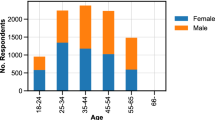Abstract
Manpower Planning is a useful tool for human resource management in large organizations. Classical Manpower Planning models are analytical time-discrete push and pull models. Push models are characterized by the same promotion and wastage probabilities for people within the same group. This assumption is suitable in organizations where for instance promotions are used for reasons of personnel motivation or employees are promoted after succeeding in an exam. In many organizations, people are only promoted when there are vacancies at other levels. In those cases, pull models can be used. Pull models only assume known wastage probabilities. In practice, both assumptions may occur simultaneously. In this paper, a mixed push-pull model is developed for organizations in which both types of flows are considered.
Similar content being viewed by others
References
Bartholomew, D. J. (1977). Maintaining a grade or age structure in a stochastic environment. Advances in Applied Probability, 9, 1–17.
Bartholomew, D. J., Forbes, A. F., & McClean, S. I. (1991). Statistical techniques for manpower planning. Chichester: Wiley.
Brockbank, W. (1999). If HR were really strategically proactive: present and future directions in HR’s contribution to competitive advantage. Human Resource Management, 38(4), 337–352.
De Feyter, T. (2003). Manpower planning based on a multivariate analysis of an historical dataset. Leuven: Katholieke Universiteit Leuven (Master thesis).
De Feyter, T. (2006). Modeling heterogeneity in Manpower Planning: dividing the personnel system in more homogeneous subgroups. Applied Stochastic Models in Business and Industry, 22(4), 321–334.
Ferris, G. R., Buckley, M. R., & Allen, G. M. (1992). Promotion systems in organizations. Human Resource Planning, 15, 47–68.
Gantmacher, F. (1964). The theory of matrices. New York: Chelsea.
Geerlings, W. S. J., Verbraeck, A., & de Groot, R. P. T. (2001). Manpower forecasting: a discrete-event object-oriented simulation approach. In Proceedings of the 34th Hawaii international conference on system sciences (Vol. 3, pp. 3005–3015).
Georgiou, A. C., & Tsantas, N. (2002). Modelling recruitment training in mathematical human resource planning. Applied Stochastic Models in Business and Industry, 18, 53–74.
Georgiou, A. C., & Vassiliou, P.-C. G. (1997). Cost models in nonhomogeneous Markov systems. European Journal of Operations Research, 100, 81–96.
Guerry, M. A. (1999). Using fuzzy sets in manpower planning. Journal of Applied Probability, 36(1), 155–162.
Kemp, M. C., & Kimura, Y. (1978). Introduction to mathematical economics. New York: Springer.
Koev, P. S. (2005). Accurate eigenvalues and SVDs of totally nonnegative matrices. SIAM Journal on Matrix Analysis & Applications, 27(1), 1–23.
MacCluer, C. R. (2000). The many proofs and applications of Perron’s theorem. SIAM Review, 42(3), 487–498.
McClean, S. (1991). Manpower planning models and their estimation. European Journal of Operational Research, 51, 179–187.
McClean, S. I., & Montgomery, E. J. (2000). Estimation for semi-Markov manpower models in a stochastic environment. In J. Janssen & N. Limnios (Eds.), Semi-Markov models and applications (pp. 219–227). Dordrecht: Kluwer Academic.
Parker, B., & Caine, D. (1996). Holonic modeling: human resource planning and the two faces of Janus. International Journal of Manpower, 17(8), 30–45.
Seneta, E. (1973). Non-negative matrices. London: George Allen & Unwin.
Smith, A. R., & Bartholomew, D. J. (1988). Manpower planning in the United Kingdom: an historical review. Journal of the Operational Research Society, 39(3), 235–248.
Tsantas, N. (2001). Ergodic behavior of a Markov chain model in a stochastic environment. Mathematical Methods of Operations Research, 54(1), 101–118.
Tsantas, N., & Georgiou, A. C. (1998). Partial maintainability of a population model in a stochastic environment. Applied Stochastic Models and Data Analysis, 13, 183–189.
van Veen, K., Geerlings, W. S. J., & Popping, R. (2001). Generating job mobility patterns. Research Report nr. 01A11, University of Groningen–Research Institute SOM.
Yadavalli, V. S. S., & Natarajan, R. (2001). A semi-Markov model of a manpower system. Stochastic Analysis and Applications, 19(6), 1077–1086.
Yadavalli, V. S. S., Natarajan, R., & Udayabhaskaran, S. (2002). Time dependent behavior of stochastic models of manpower system—impact of pressure on promotion. Stochastic Analysis and Applications, 20(4), 863–882.
Author information
Authors and Affiliations
Corresponding author
Rights and permissions
About this article
Cite this article
De Feyter, T. Modeling mixed push and pull promotion flows in Manpower Planning. Ann Oper Res 155, 25–39 (2007). https://doi.org/10.1007/s10479-007-0205-1
Published:
Issue Date:
DOI: https://doi.org/10.1007/s10479-007-0205-1




